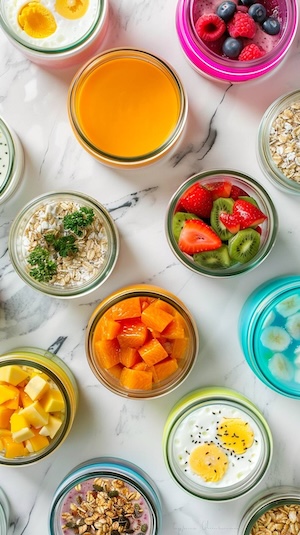PCOS for Picky Eaters: 30 Simple Meal Ideas
Discover 30 simple pcos meals for picky eaters that help manage symptoms. Easy pcos meals picky eaters will love, with practical tips and hormone-balancing ingredients.
Transform your health with tailored 7-day meal plans designed specifically for PCOS management. Just $7/month or $59/year.
Get it now →1 whole fryer chicken (2 1/2 to 3 pounds), cut into 10 parts
1 quart buttermilk, well shaken
1 1/2 tablespoons dry mustard powder
1 1/4 teaspoons cayenne
Coarse salt and freshly ground pepper
1 1/2 cups all-purpose flour
2 tablespoons yellow cornmeal
Neutral-tasting oil, such as safflower, for frying
Place chicken parts in one or two shallow dishes, just large enough to hold them snugly. In a medium bowl, whisk together the buttermilk, mustard powder, and 1 teaspoon cayenne; season with salt and pepper. Pour marinade over the chicken, making sure the parts are completely submerged. (Alternatively, divide the chicken and marinade evenly among large resealable bags; rest the bags on a rimmed baking sheet to catch any leaks.) Cover tightly and refrigerate at least 4 hours or up to overnight. Remove chicken from the marinade and allow to drain on a wire rack set over a rimmed baking sheet for 1 hour before cooking (discard marinade). Meanwhile, whisk together the flour, cornmeal, and remaining 1/4 teaspoon cayenne; season with salt and pepper. Spread mixture in a shallow dish. When you are ready to begin frying, pour a scant 1/2 inch oil into a large cast-Iron skillet and heat over medium until oil registers 375 degrees F on a deep-fry thermometer. (Alternatively, test by dropping a cube of white crustless bread into the oil; it should turn golden brown within 1 minute.) While the oil is heating, and working with a few parts at a time, dredge chicken in the flour mixture, turning to completely coat. Shake off excess flour and set chicken on a parchment-lined baking sheet as you work. Preheat oven to 200 degrees F. Set a clean wire rack on a rimmed baking sheet with several layers of paper towels on top of rack. Working in batches (skillet should be filled but without pieces touching each other), arrange chicken, skin side down, in a single layer. Adjust heat so temperature of oil remains between 330 degrees F and 340 degrees F during frying. Cover and cook until chicken is crisp and golden on bottom and parts remove easily from pan, 4 to 5 minutes. Carefully turn chicken and continue frying (covered) until crisp and cooked through (breasts should register 160 degrees F and thighs 165 degrees F on an instant-read thermometer), 4 to 5 minutes more. Remove each part as soon as it is ready (wings, drumsticks, and thinner breast pieces cook faster than thighs). Transfer to prepared rack on baking sheet and keep warm in the oven while cooking remaining chicken, returning oil to 375 degrees F before adding each batch. Serve chicken hot.
Reprinted with permission from Martha's American Food by Martha Stewart, Clarkson Potter copyright (c) 2012

You know the drill: Alarm goes off. You hit snooze. Rush around frantically. Skip breakfast AGAIN because there's no time. By 10am, you're hangry, your blood sugar is all over the place, and your PCOS symptoms are already acting up.
Sound familiar?
Finally – a meal prep system designed specifically for women with PCOS who refuse to let chaotic mornings derail their health goals.
In just ONE hour on Sunday, you can transform your entire week:
"I went from skipping breakfast 4 days a week to having delicious, hormone-supporting meals ready every morning. My energy is more stable and my cravings have disappeared!"
– Sarah M.
Stop letting chaotic mornings control your health.
Get your hormone-happy mornings starting this Sunday.
→ Get Your 60-Minute Solution Now
Transform your health with tailored 7-day meal plans designed specifically for PCOS management. Just $7/month or $59/year.
Get it now →Serving Size: 0
| Amount Per ONE Serving | ||
|---|---|---|
| Calories 0 kcal | ||
| Fat 0 g | ||
| Carbohydrate 0 g | ||
| Protein 0 g | ||
💡 Introducing the 10/10 PCOS Solution:
Ten Delicious Crockpot Recipes that take just 10 minutes to prep!
Say goodbye to hours in the kitchen and hello to clean, PCOS-friendly meals made effortlessly.
👉 Click here to grab your 10/10 PCOS Solution today! Try The 10/10 PCOS Solution: Ten Crockpot Recipes That Take Just Ten Minutes to Prep
Managing PCOS can be challenging, but you don't have to do it alone. Join our supportive community to connect with others who understand what you're going through, share tips, and get encouragement. Here's how you can get involved:
Subscribe to our Newsletter: Receive PCOS-friendly recipes, tips, research updates, and more delivered straight to your inbox. Stay informed and empowered with the latest information and support.
Join our Telegram Channel: Stay updated with the latest tips and advice on managing PCOS.
Follow PCOS Meal Planner on Facebook: Engage with our community, participate in discussions, and get support from others.
Break the cycle with the PCOS Meal Planner - your personalized guide to eating better, feeling better, and managing PCOS symptoms. Take control today!

Forget the frustrating cycle of weight loss attempts, endless medications, and living in discomfort. Introducing the PCOS Meal Planner. A meal planning guide that goes beyond temporary fixes to offer a comprehensive strategy, empowering you to ignite a transformation towards lasting health and happiness. Step into a world where you control your PCOS, not the other way around.
Unlock Your PCOS Freedom Now.
Discover 30 simple pcos meals for picky eaters that help manage symptoms. Easy pcos meals picky eaters will love, with practical tips and hormone-balancing ingredients.
Discover 15 delicious overnight oats for PCOS recipes that help balance hormones and manage symptoms. Easy, nutritious breakfast ideas perfect for women with PCOS.
Discover the best cereal for PCOS with our expert rankings. Compare brands, check ingredients, and find PCOS friendly cereal that supports hormonal balance.
Learn how to transition away from fruit when starting a ketogenic diet for PCOS. Discover gradual strategies, fruit alternatives, and practical tips for success.
Discover 5 delicious PCOS banana bread recipes with low-glycemic ingredients. Learn how to make hormone-friendly banana bread that supports blood sugar balance.
Creatine for women with PCOS explained simply. Learn safety, benefits, hormone effects, tips, and how creatine may support PCOS symptoms naturally.
Complete PCOS diet plan with foods to eat, foods to avoid, meal timing, and real results. Learn the science-backed approach to managing PCOS through diet, with 7-day meal plan, grocery list, and step-by-step implementation guide. Based on clinical research and real patient outcomes.
Complete guide to ordering at Wendy's with PCOS. Discover the best protein-focused meals, what to skip, and how to customize orders to keep blood sugar stable. Learn which burgers, salads, and sides work for PCOS, plus complete macros for every menu item and smart swaps to avoid insulin spikes.
Complete guide to ordering at Burger King with PCOS. Discover the best protein-focused meals, what to skip, and how to customize orders to keep blood sugar stable. Learn which burgers, salads, and sides work for PCOS, plus complete macros for every menu item and smart swaps to avoid insulin spikes.